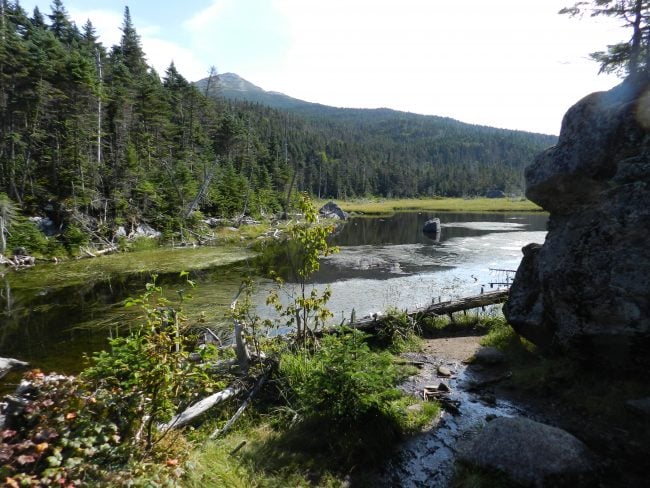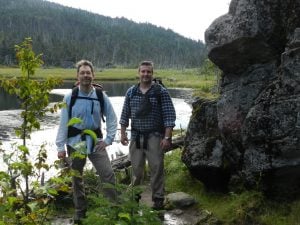Riverkeeper completes first-of-its-kind survey of Hudson River water quality – starting at the source

View more images on our Flickr site
Contact: Leah Rae, Riverkeeper, (914) 478-4501 ext. 238, [email protected]
Scientists hike to Lake Tear of the Clouds on state’s highest peak to complete 315-mile-long snapshot of water quality from source to sea, and inspire fresh look at the Hudson
Ongoing monitoring project has biggest month ever in August: 160 community scientists and three dozen partner organizations support sampling at nearly 400 locations on nearly 800 miles of water
Ossining, N.Y. – Water samples gathered this week at the Hudson River’s source, Lake Tear of the Clouds, complete a first-of-its kind snapshot of water quality along the entire 315-mile-long Hudson River, from Mount Marcy, the highest peak in the Adirondacks, to the shadow of the Statue of Liberty in New York Harbor.
Test results from samples collected in the Hudson’s headwaters, at an elevation of 4,295 feet, by Riverkeeper’s longtime collaborators at CUNY Queens College and Columbia University’s Lamont-Doherty Earth Observatory represent the first samples taken by Riverkeeper and our partners in the headwaters of the river we have been dedicated to protecting since our founding 50 years ago.
The results (click here to view interactive maps) add to a growing water quality database at Riverkeeper.org, and will help shed light on how and where sewage and other fecal contamination occurs along the river’s pathway to the sea.
Riverkeeper and these university partners first piloted microbial water quality sampling in the Lower Hudson River in 2006, and started routine monthly monitoring of the entire tidal portion of the Hudson River Estuary from New York Harbor to The Capital District in 2008. Community scientists working with Riverkeeper have extended the effort over the last several years, volunteering their time to sample in 12 tributaries of the Hudson River and at more than 40 public access points around New York City. In August alone, Riverkeeper and our partners sampled water quality at nearly 400 locations on nearly 800 miles of the water – the most to date in a single month.
“Every sample taken is a vote for clean water,” Riverkeeper Water Quality Program Manager Dan Shapley said. “We’re not only helping to fill a data gap by reporting to the public information about when and where it is safe to swim, but also demonstrating that people care deeply about the health of the streams and creeks that run through their communities.”
The sampling program was extended north from the Capital District in August through a collaboration between Riverkeeper partners CUNY Queens College, Lamont-Doherty Earth Observatory, SUNY Cobleskill and Jarrett Engineers. This Upper Hudson sampling project, conducted August 23 and 28, wrapped up a month of sampling that included Riverkeeper’s monthly patrol from New York Harbor to the Capital District, August 14-18, as well as monthly monitoring by community scientists and three dozen partner organizations in the East, Mohawk, Pocantico, Saw Mill and Wallkill Rivers; and in the Catskill, Esopus, Roeliff Jansen Kill, Rondout, Saw Kill and Sparkill creeks; and weekly monitoring at public access points in New York City and Ossining.
On Tuesday, Aug. 23, Riverkeeper conducted sampling from its patrol boat from Troy to Fort Edward. SUNY Cobleskill assisted by gathering samples from tributaries inaccessible by boat and processing samples. Tom Jarrett and his firm, Jarrett Engineers, assisted by collecting samples from From Fort Edward to Newcomb.
 On Sunday, Aug. 28, two of Riverkeeper’s longtime science collaborators, Gregory O’Mullan, PhD, of CUNY Queens and Andrew Juhl, PhD, of Lamont-Doherty, hiked into the High Peaks of the Adirondacks to collect samples at Lake Tear of the Clouds and then downstream from the source to Newcomb, N.Y.
On Sunday, Aug. 28, two of Riverkeeper’s longtime science collaborators, Gregory O’Mullan, PhD, of CUNY Queens and Andrew Juhl, PhD, of Lamont-Doherty, hiked into the High Peaks of the Adirondacks to collect samples at Lake Tear of the Clouds and then downstream from the source to Newcomb, N.Y.
Andrew Juhl, Lamont Associate Research Professor, said: “We thought that hiking up to the highest source of the Hudson River would be a great way to celebrate our 10th year of partnering with Riverkeeper. It turned out to be a much more strenuous hike than we thought it would be, particularly with all the equipment we carried with us, but it was totally worth the effort. Gathering data from the most remote and least human-influenced portion of the Hudson provides us with really important context for understanding our results in the lower regions, where human influence is so dramatic.”
Gregory O’Mullan, Associate Professor at CUNY Queens College, said: “Ten years into our partnership to study the Hudson, the project continues to grow and to provide new insights, such as this snapshot of the entire system from source to sea. The health of the Hudson is influenced by human actions and decisions. Some of those actions cause degradation while others foster restoration or maintenance of pristine conditions. It is a privilege to share our experiences with this beautiful river, especially from the less traveled, more pristine areas that provide a glimpse into what is possible in all parts of the river.”
The project has raised awareness about water quality issues broadly and helped to identify and stop specific local sources of pollution. Both the data gathered and the community of people engaged to gather the data have helped advocate successfully for transformative policy, including the Sewage Pollution Right to Know Law and the Water Infrastructure Improvement Act.
Riverkeeper is advocating for renewal of the Infrastructure Improvement Act, and $800 million in annual funding for it, as well as restoration of staff and budget for the Department of Environmental Conservation and enhanced drinking source water protection efforts that will continue to improve water quality.
Data from the sampling project is updated monthly. Click here to explore.
Andy Juhl of Lamont-Doherty Earth Observatory and Greg O'Mullan of Queens College test the water quality in Lake Tear of the Clouds, the source of the Hudson River high in the Adirondacks of New York. – Spherical Image – RICOH THETA


